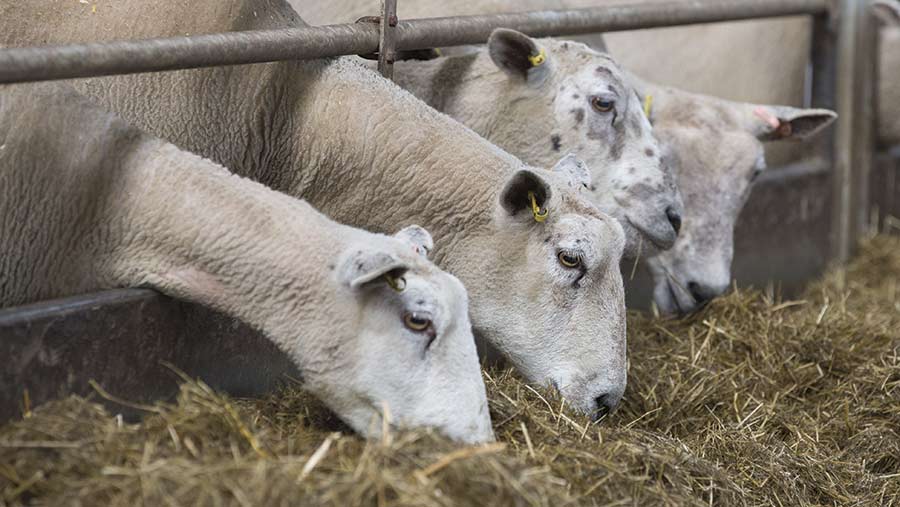Flockmasters advised to get silage analysed to meet ewe requirements
 © Tim Scrivener
© Tim Scrivener Huge variations in the quality of the 2016 silage crop mean forage analysis is vital to manage ewe nutrition effectively in the run-up to lambing, consultants have warned.
The final six weeks of pregnancy is a cruciaI time for ewe nutrition as 70% of a lamb’s birthweight is added.
See also: More advice on ewe nutrition
Avoiding pregnancy toxaemia and hypocalcaemia, along with boosting the ewe’s milk supply and colostrum production, all depend on getting nutrition right at this time, explains sheep consultant Lesley Stubbings.
But silage protein and energy levels are more variable than we have seen for years, Ms Stubbings says.
Changeable weather at silage-making in 2016 meant harvesting windows were tight. While some farmers enjoyed perfect silaging conditions others missed out and cutting was delayed.
“Quality differs from one farm to the next. There is no blueprint ration that can be applied across different farms,” says Ms Stubbings.
“It’s important to avoid following the routine of what was fed last year. The starting point for any feeding in late-pregnancy must be to get silage analysed,” she says.
In Scotland SAC nutritionist Karen Stewart adds she fears some silage protein levels are below safe limits.
“We are very concerned that more samples this year have protein levels below the 10% level which we would consider critical for most stock,” Ms Stewart says.
For these cases she recommends seeking professional nutritional advice to provide a suitable protein supplement.
Big bale silage analysis confirms wide variation |
|||
|
Analysis of 2,400 big bale samples received by Trouw Nutrition GB between 1 June and 22 November from farms across the UK. |
|||
|
Big Bale |
Average |
Min |
Max |
|
Dry matter |
41.3 |
14.1 |
86.4 |
|
Protein |
13.5 |
4.8 |
25.8 |
|
D value |
63.1 |
57.9 |
75.8 |
|
ME |
10.1 |
9.3 |
12.1 |
|
pH |
4.7 |
3.6 |
7.4 |
|
Acid load |
40.4 |
22.4 |
55.7 |
|
Fibre index |
214.5 |
162.1 |
309.1 |
|
Source: Trouw Nutrition GB, 2016 |
|||
Trouw ruminant nutritionist Rosie Miller says the results underline the concern with protein and energy levels in crops but with accurate forage analysis, decisions could be made to best use and supplement the forages available on farm.
Trouw’s analysis shows crude protein was as high as 25.8% in samples – more than five times higher than the poorest samples at less than 5%.
“A high pH [+5] can indicate poor fermentation. Poorly fermented silages could be at risk of spoilage and moulds. Any spoiled silage should be discarded,” says Ms Miller.
Balancing acid loading in diets is also important. Understanding the acid load and fibre index of forages can be help when balancing the overall diet, aiming to reduce the risk of acidosis, she says.
“A wet, acidic forage may not balance the acid loading of a high energy concentrate as well as a more fibrous forage. So the risk of acidosis may be greater at the same level of concentrate feeding,” Ms Miller adds.
Condition scores
Ms Stubbings advises that in addition to the forage analysis flock owners should assess ewe body condition scores carefully this year.
“For lowland ewes scores of 3.0 – 3.5 and for hill ewes 2.5 – 3.0 should be maintained for the six weeks, right through to lambing.
“A good starting point is handling the ewe at scanning, then again when clostridial boosters are given. But it is best to monitor the condition score as regularly as possible. If they are not holding condition, take advice,” she says.
The energy and protein requirements of pregnant ewes increase significantly in the last six weeks of pregnancy.
The growing lamb also restricts the ewe’s rumen capacity reducing her appetite by 30%, according to the AHDB.
That makes it necessary to feed an additional high-quality protein for lamb growth and colostrum production needed at about 50g/kg lamb birthweight.
A 70kg ewe’s metabolisable energy (ME) and metabolisable protein (MP) requirement. |
||||||||
|
Weeks pre-lambing |
||||||||
|
|
7 |
5 |
3 |
1 |
||||
|
Number of lambs |
ME |
MP |
ME |
MP |
ME |
MP |
ME |
MP |
|
|
(MJ) |
(g) |
(MJ) |
(g) |
(MJ) |
(g) |
(MJ) |
(g) |
|
1 |
10.2 87 |
87 |
11.2 |
92 |
12.6 |
98 |
14.4 |
107 |
|
2 |
11.4 |
93 |
13.1 |
101 |
15.3 |
112 |
18.3 |
126 |
|
3 |
12.0 |
96 |
14.0 |
106 |
16.7 |
119 |
20.3 |
136 |
|
Source AHDB: Sheep manual 12 – Improving ewe nutrition for Better Returns |
||||||||
According to the AHDB feed intakes as a percentage of body weight also rise in late pregnancy to about 2% of the ewe’s bodyweight or about 1.5kg dry matter per day for a 70kg ewe.
Recommended feed space allowances
- Concentrate in troughs 45cm a head for larger ewes
- Forage ad-lib 15cm a head
- Restricted forage 25cm
Source: Defra 2003
To assess whether there is enough forage to meet these intakes Ms Stubbings advises weighing bales and dividing the weight by the number of ewes to get a figure per head.
It’s also important to check there is sufficient trough space for each one to feed, she says.
“Observe the ewes feeding to see whether all are getting the chance to feed.
“A tell-tale sign is when they have dirty backs it means they have been clambering over each other to get food.
“It means there is not sufficient space to feed and that food is not available long enough,” Ms Stubbings says.
